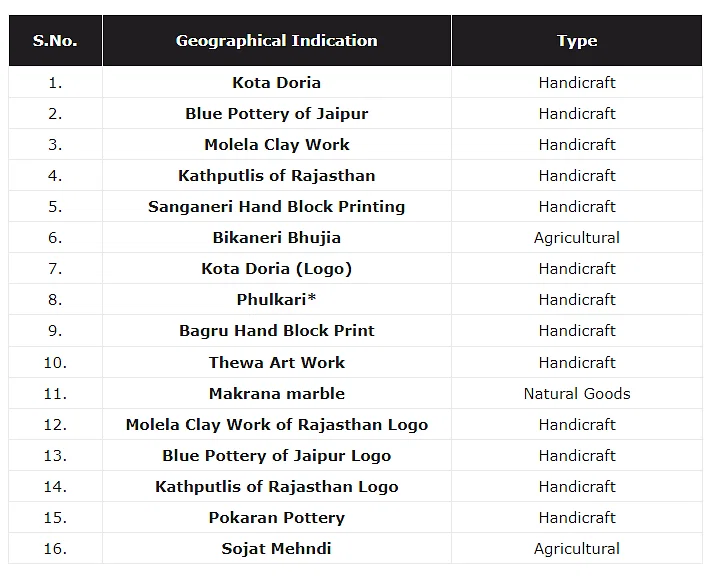GI tags are given to crafts from Rajasthan, mangoes grown in Goa
Context:
The Geographical Indications Registry in Chennai awarded the Geographical Indication (GI) label to seven items from all over India, including four from Rajasthan.
The items that received the label included the Jalesar Dhatu Shilp (metal craft), Goa Mankurad mango, Goan Bebinca, Udaipur Koftgari metal craft, Bikaner Kashidakari craft, Jodhpur Bandhej craft, and Bikaner Usta Kala craft.
What are GI tags?
- Identification of Origin: A GI’s main purpose is to indicate that a product comes from a specific area of the world. This aids customers in differentiating products depending on their country of origin and helps them make wise purchases.
- Link to Place of Origin: A product’s attributes, traits, or reputation should largely be attributed to its place of origin. The distinctive characteristics of the product are influenced by geographical aspects such as climate, soil, conventional wisdom, cultural practices, and others.
- Protection and Regulation: In many nations and regions, geographical indications are legally protected. Laws and regulations specify the requirements for a product to be recognised as a GI and offer safeguards against unauthorised use, false labelling, or product imitation. The Geographical Indications of Goods (Registration and Protection) Act, 1999 aims to better safeguard geographical indications used in connection with commodities in India by allowing for their registration.
- Product Categories: Different product categories, such as agricultural commodities, food and drinks, handicrafts, textiles, and industrial goods, might use geographic indicators. Wines, cheeses, fruits, handicrafts, and textiles are a few examples.
- Information for Consumers: GIs give consumers useful details about the source and calibre of products. Customers can rely on the distinctive qualities, standing, and traditional knowledge connected to items from particular geographical areas.
- Economic Benefits: Geographical indications have a positive economic impact on local and regional economies. By giving local producers a market for their distinctive goods, they support local producers, maintain cultural heritage, and promote and protect traditional knowledge.
- Cultural and environmental preservation: GIs contribute to the preservation of regionally specific natural resources, traditional production techniques, and cultural practices. This stimulates biodiversity preservation and sustainable practices.
- International Recognition: Geographical indications may also be given worldwide status using conventions and treaties. Examples include the protection of GIs under the Agreement on Trade-Related Aspects of Intellectual Property Rights (TRIPS) of the World Trade Organisation.
What Rights do GI tags provide?
- Geographical indication rights grant the ability to restrict the use of an indication by a third party that doesn’t meet the relevant standards.
- Producers with the Darjeeling geographical indication can prevent the use of “Darjeeling” for tea that isn’t grown in their gardens or produced according to specified standards.
- Protected geographical indications don’t prevent others from using the same techniques outlined in the standards for that indication.
- Obtaining protection for a geographical indication often involves acquiring rights over the corresponding sign or symbol.
What are the types of products that GI tags are used for?
- Geographical indications are typically used for agricultural products, foodstuffs, wine and spirit drinks, handicrafts, and industrial products.
What are the latest products that got GI tags?
- Jalesar Dhatu Shilp (Metal Craft):
-
-
- Jalesar Dhatu Shilp (Metal Craft) is situated in the Uttar Pradesh district of Etah.
- Making brassware and ornate metal crafts is considered to be a craft.
- Meaning: Jalesar is renowned for its long history of metalworking, producing intricately crafted brassware and metal items.
- GI Tag: The GI tag recognizes the cultural relevance and tradition of Jalesar’s metalwork while safeguarding its distinct identity.
-
- Goa Mankurad Mango:
-
-
- Goa Mankurad Mango is found in India’s Goa.
- Mango of the Mankurad kind, whose name is derived from the Portuguese word “malcorada,” which means “poorly coloured.”
- Meaning: The mango has a long history with Goa, and the state’s fascinating culture is reflected in its unusual name.
- GI Tag: The GI tag helps to maintain the Mankurad mango’s traditional cultivation and production methods as well as its authenticity in Goa.
-
- Goan Bebinca:
-
-
- Goan Bebinca: Found in India’s Goa.
- delicacy: This pudding-like dish is a classic Indo-Portuguese delicacy.
- Bebinca is regarded as the “Queen of Goan Desserts” and has strong cultural origins in the local cuisine.
- GI Tag: The GI tag denotes the historical and cultural significance of Goan Bebinca and forbids the misuse of its name and manufacturing.
-
- Udaipur Koftgari Metal Craft:
-
-
- Udaipur Koftgari Metal Craft is located in the Indian state of Rajasthan.
- involves the traditional Koftgari craft, which is used to create decorative weapons.
- Process: This involves etching designs into the metal, inserting gold and silver wire, and polishing the finished goods.
- Meaning: The Koftgari workmanship from Udaipur is a representation of the expert craftsmanship of artisans and the age-old metalworking methods handed down through the centuries.
- GI Tag: The Koftgari metal craft of Udaipur is recognized and protected by the GI tag for its exceptional craftsmanship.
-
- Jodhpur Bandhej Craft.
-
-
- Location: Jodhpur, Rajasthan, India.
- Craft: Describes the Rajasthani practice of tying and dying fabric to produce a variety of patterns.
- Importance: Rajasthan’s textile tradition includes bandhej craft, which is frequently utilized to produce brilliant and colourful fabrics.
- Bandhej craft from Jodhpur is made using traditional methods and patterns, which are preserved thanks to the GI tag.
-
- Usta Kala Bikaner Craft:
-
- Location: Rajasthan, India’s Bikaner.
- Craft: It primarily features golden colour and has a lasting effect. It is also known as gold nakashi work or gold manauti work.
- Meaning: The Usta Kala craft of Bikaner is a prime example of the meticulous use of gold in artwork, showcasing the creative legacy of the area.
- GI Tag: The GI tag protects the traditional techniques and designs of Bikaner’s Usta Kala craft.





